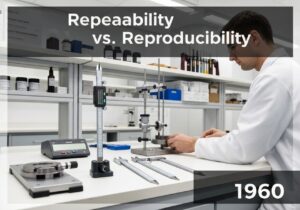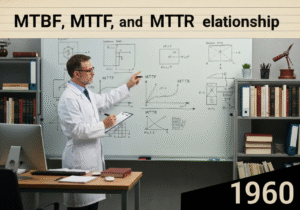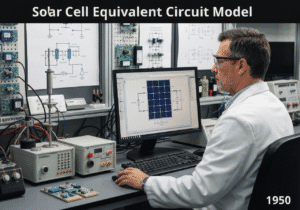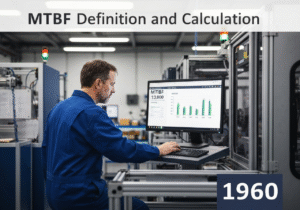Une étude statistique formelle visant à déterminer si un système de mesure est capable de fournir des données fiables en quantifiant son exactitude, sa précision (répétabilité et reproductibilité), sa stabilité et son biais.
- Méthodologies : Clients et marketing, Économie, Lean Sigma, Fabrication, Gestion de projet, Qualité
Analyse des systèmes de mesure (MSA)

Analyse des systèmes de mesure (MSA)
- Capacité de traitement, Amélioration des processus, Assurance qualité, Contrôle de qualité, Gestion de la qualité, Six Sigma, Contrôle statistique des processus (CSP)
Objectif :
Comment il est utilisé :
- Il utilise des outils tels que les études de répétabilité et de reproductibilité des jauges (Gage R&R), les études de linéarité et les études de stabilité. Plusieurs évaluateurs mesurent plusieurs fois les mêmes pièces afin d'isoler et de quantifier les sources de variation au sein du système de mesure.
Avantages
- Confiance dans les données utilisées pour prendre des décisions cruciales sur la qualité des produits ou sur l'efficacité de la production. contrôle de processusUn élément clé des systèmes de gestion de la qualité tels que l'IATF 16949.
Inconvénients
- Elle nécessite une planification et une exécution minutieuses afin de garantir la validité des résultats. Elle peut nécessiter des ressources importantes, car elle requiert du personnel formé et du temps dédié à cette tâche.
Catégories :
- Lean Sigma, Fabrication, Qualité
Idéal pour :
- Évaluer la capacité des systèmes de mesure à fournir des données fiables pour l'analyse, le contrôle des processus et l'acceptation des produits.
L'analyse des systèmes de mesure (ASM) est une méthodologie fondamentale qui met l'accent sur la vérification des outils et des processus de mesure dans divers secteurs, notamment la fabrication, l'automobile, l'aérospatiale et les produits pharmaceutiques, où la précision et l'exactitude font partie intégrante de l'assurance de la qualité. La MSA peut être lancée pendant la phase de conception du cycle de vie d'un produit, ce qui permet aux ingénieurs et aux professionnels de la qualité de valider les outils de mesure avant le début de la production. Différents membres de l'équipe, notamment des ingénieurs qualité, des ingénieurs de processus et des responsables des opérations, collaborent à la réalisation d'études Gage R&R, qui évaluent à la fois la répétabilité et la reproductibilité des systèmes de mesure en comparant les résultats de plusieurs évaluateurs dans le cadre de mesures répétées des mêmes pièces. Cette approche méthodologique englobe également les études de linéarité, qui évaluent l'évolution de la précision des mesures en fonction de différentes valeurs, et les études de stabilité, qui vérifient si la précision des mesures est constante dans le temps lors de l'évaluation d'une même caractéristique. En identifiant et en quantifiant les erreurs de mesure, l'ASM ne se contente pas d'instaurer la confiance dans les données collectées, mais fournit également aux équipes les informations nécessaires pour prendre des décisions éclairées concernant l'amélioration des processus et la finalisation des produits. Les industries qui adhèrent à des normes telles que l'IATF 16949 en tirent un grand bénéfice, car la MSA s'aligne sur les pratiques de gestion de la qualité qui visent à réduire les variations et à améliorer la satisfaction des clients grâce à des processus de mesure fiables. Une mise en œuvre régulière permet non seulement de renforcer les capacités internes, mais aussi d'établir un cadre pour l'amélioration continue, garantissant que les organisations peuvent répondre aux exigences réglementaires en constante évolution et aux attentes du marché.
Principales étapes de cette méthodologie
- Définir le système de mesure et son objectif.
- Sélectionner les instruments de mesure et définir leurs spécifications.
- Organiser plusieurs évaluateurs pour qu'ils effectuent les mesures de manière indépendante.
- Veiller à ce que les conditions d'essai soient normalisées pour toutes les mesures.
- Effectuer l'étude R&R de la jauge pour analyser la répétabilité et la reproductibilité.
- Réaliser des études de linéarité pour évaluer la précision des mesures sur l'ensemble de la gamme.
- Réaliser des études de stabilité pour évaluer la cohérence des mesures dans le temps.
- Analyser les données collectées pour déterminer les sources de variation.
- Mettre en œuvre des actions correctives pour remédier aux erreurs de mesure identifiées.
- Documenter les résultats et mettre à jour les protocoles du système de mesure si nécessaire.
Conseils de pro
- Réaliser des études de R&R sur les jauges avec différents évaluateurs afin de saisir avec précision les facteurs de répétabilité et de reproductibilité, en réduisant les biais dus aux préférences spécifiques des opérateurs.
- Mettre en œuvre une approche structurée des études de linéarité en évaluant plusieurs gammes de mesures afin de s'assurer que le système de mesure fonctionne de manière cohérente dans les limites opérationnelles.
- Réaliser régulièrement des études de stabilité sur des périodes prolongées, afin d'identifier les tendances ou les dérives des systèmes de mesure qui pourraient compromettre l'intégrité des données.
Lire et comparer plusieurs méthodologies, nous recommandons le
> Référentiel méthodologique étendu <
ainsi que plus de 400 autres méthodologies.
Vos commentaires sur cette méthodologie ou des informations supplémentaires sont les bienvenus sur le site web de la Commission européenne. section des commentaires ci-dessous ↓ , ainsi que toute idée ou lien en rapport avec l'ingénierie.
Contexte historique
1950
1950
1959-11
1960
1960
1960
1961
1950
1950
1950
1960
1960
1960
1960
1963
(si la date est inconnue ou n'est pas pertinente, par exemple "mécanique des fluides", une estimation arrondie de son émergence notable est fournie)














Articles Similaires
Questionnaires sur les troubles musculo-squelettiques
Tests à plusieurs variables (MVT)
Analyse de régression multiple
Systèmes de capture de mouvement
Méthode MoSCoW
Test de la médiane de Mood